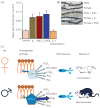How it's made: organisational effects of hormones on the developing brain
- PMID: 20646174
- PMCID: PMC3170038
- DOI: 10.1111/j.1365-2826.2010.02021.x
How it's made: organisational effects of hormones on the developing brain
Abstract
Gonadal steroid hormones exert permanent organisational effects on the developing brain and thereby direct adult hormonal responsiveness to dictate sex-specific behaviour and physiology. Considerable progress has been made in elucidating the cellular mechanism of action of androgens and oestrogens during the perinatal sensitive period during which organisation occurs. This review highlights the findings obtained with respect to differential cell death and synaptogenesis with an emphasis on region-specific mechanisms that involve diverse signalling molecules including tumour necrosis factor-alpha, BAX, GABA, glutamate, prostaglandin E(2), FAK and paxillin.
Figures




References
-
- Morris JA, Jordan CL, Breedlove SM. Sexual differentiation of the vertebrate nervous system. Nat Neurosci. 2004;7:1034–1039. - PubMed
-
- Wallen K. Hormonal influences on sexually differentiated behavior in nonhuman primates. Front Neuroendocrinol. 2005;26:7–26. - PubMed
-
- Breedlove SM. Sexual differentiation of the human nervous system. Annu Rev Psychol. 1994;45:389–418. - PubMed
-
- Hines M. Sexual differentiation of human brain and behavior. In: Pfaff D, editor. Hormones, Brain and Behavior. London: Academic Press; 2002. pp. 425–462.
-
- Phoenix CH, Goy RW, Gerall AA, Young WC. Organizing action of prenatally administered testosterone proprionate on the tissues mediating mating behavior in the female guinea pig. Endocrinology. 1959;65:369–382. - PubMed
Publication types
MeSH terms
Substances
Grants and funding
LinkOut - more resources
Full Text Sources
Research Materials
Miscellaneous

